Currently, I'm developing software in C++20 that calculates driving and occupancy times for the automatic timetable construction
at DB Systel GmbH.
Prior to that, I was developing software in Python and JavaScript using agile methods, CI/CD and cloud technology at d-fine GmbH.
I'm a former researcher at the Dalle Molle institute for artificial intelligence
(IDSIA) in Lugano, Switzerland in the group of
Prof. Dr. Juergen Schmidhuber.
I have been working on a project dealing with curiosity in Reinforcement Learning
[technical_report][code].
During this time I have also given three lectures on Evolutionary Algorithms [pdf].
My scientific background is originally in physics. I have obtained my diploma and PhD
in theoretical high energy physics at
the Johannes Gutenberg-University in Mainz,
Germany, under the supervision of
Prof. Dr. Matthias Neubert.
In my research I have investigated Higgs and flavour physics in models with one warped extra dimension, the so-called
Randall-Sundrum models. My work involved model building
for elementary particles and the analytical calculation of Feynman loop-diagrams in a 5-dimensional warped space-time
and the subsequent numerical analysis using Mathematica. The predictions can then be tested in particle collision experiments
like the Large Hadron Collider at CERN near Geneva.
Scientific Peer-reviewed Publications
 Impact of warped extra dimensions on the dipole coefficients in b to s gamma transitions
Impact of warped extra dimensions on the dipole coefficients in b to s gamma transitions
R. Malm, M. Neubert, C. Schmell
[JHEP 04, 042 (2016)] [arXiv: 1509.02539 [hep-ph]] [talk][poster]
We calculate the electro- and chromomagnetic dipole coefficients in the context of the minimal Randall-Sundrum model with a Higgs sector localized on the IR brane using the five-dimensional approach, where the coefficients are expressed in terms of integrals over 5D propagators.
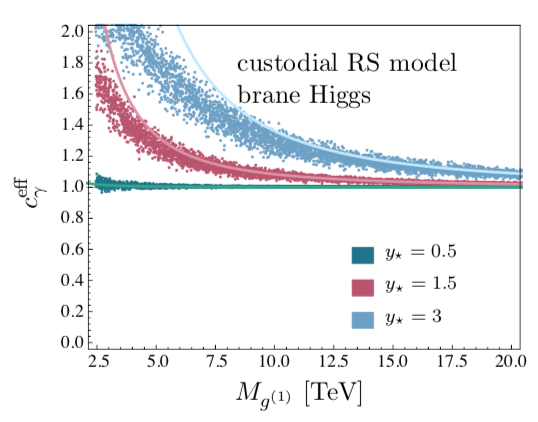 Higgs Couplings and Phenomenology in a Warped Extra Dimension
Higgs Couplings and Phenomenology in a Warped Extra Dimension
R. Malm, M. Neubert, C. Schmell,
[JHEP 02, 008 (2015)]
[arXiv: 1408.4456 [hep-ph]] [talk]
We present a comprehensive description of the Higgs-boson couplings to Standard Model fermions and bosons in Randall-Sundrum (RS) models with a Higgs sector localized on or near the infra-red brane.
 Higgs Decay into Two Photons at the Boundary of a Warped Extra Dimension
Higgs Decay into Two Photons at the Boundary of a Warped Extra Dimension
J. Hahn, C. Hörner, R. Malm, M. Neubert, K. Novotny, C. Schmell
[ Eur. Phys. J. C74, 2857 (2014)]
[arXiv: 1312.5731 [hep-ph]] [talk]
A detailed five-dimensional calculation of the Higgs-boson decay into two photons is performed in both the minimal and the custodially protected Randall–Sundrum (RS) model, where the Standard Model (SM) fields propagate in the bulk and the scalar sector lives on or near the IR brane.
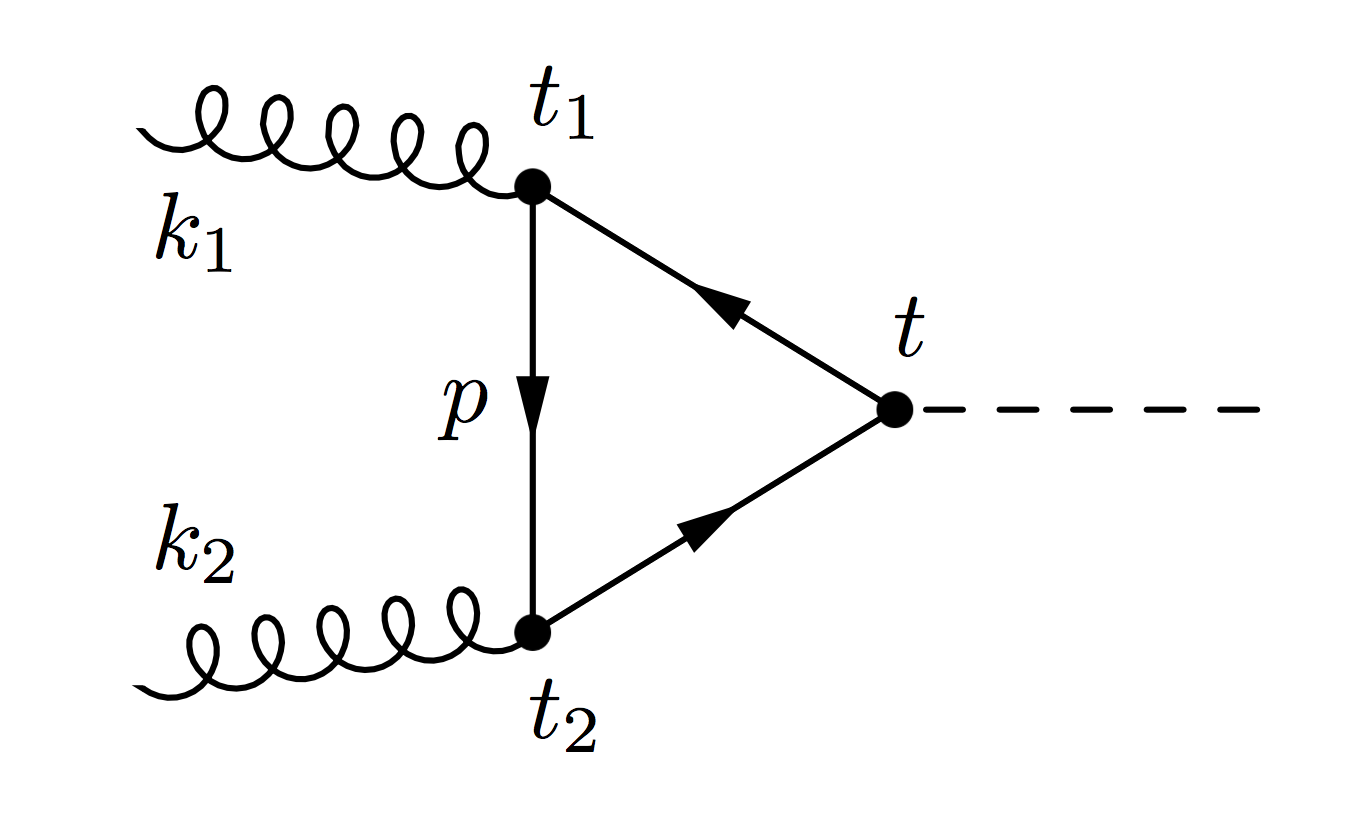 5D Perspective on Higgs Production at the Boundary of a Warped Extra Dimension
5D Perspective on Higgs Production at the Boundary of a Warped Extra Dimension
R. Malm, M. Neubert, K. Novotny, C. Schmell
[JHEP 01, 173 (2014)]
[arXiv: 1303.5702 [hep-ph]] [talk] [poster]
A comprehensive, five-dimensional calculation of Higgs-boson production in gluon fusion is performed for both the minimal and the custodially protected Randall-Sundrum (RS) model, with Standard Model fields propagating in the bulk and the scalar sector confined on or near the IR brane. For the first time, an exact expression for the gg->h amplitude in terms of the five-dimensional fermion propagator is derived, which includes the full dependence on the Higgs-boson mass.
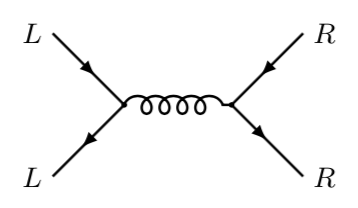 A Solution to the Flavor Problem of Warped Extra-Dimension Models
A Solution to the Flavor Problem of Warped Extra-Dimension Models
M. Bauer, R. Malm, and M. Neubert
[Phys. Rev. Lett. 108, 081603 (2012)] [arXiv: 1110.0471 [hep-ph]] [talk] [poster]
A minimal solution to the flavor problem of warped extra-dimension models, i.e. the excessive mixed-chirality contribution to CP violation in K-Kbar mixing arising from Kaluza-Klein (KK) gluon exchange, is proposed. Extending the strong-interaction gauge group in the bulk by an additional SU(3), and breaking this symmetry to QCD via boundary conditions, the constraints arising from the epsilon_K parameter are significantly relaxed.
Doctoral thesis
Five-dimensional Perspective on Higgs Physics and the b to s gamma Transition in a Warped Extra Dimension [pdf]
R. Malm, Johannes-Gutenberg University Mainz, Germany
This thesis studies the Higgs-boson production and decay processes as well as the flavor-changing neutral current
b to s gamma in models with one warped extra dimension, where the gauge bosons and fermions propagate into the bulk and the Higgs sector is localized on or near the infra-red brane.
Diploma thesis
Mitigation of the Epsilon K Fine-tuning Problem in the Randall-Sundrum Model [pdf]
R. Malm, Johannes-Gutenberg University Mainz, Germany
In order to mitigate the tension
between the theoretical and the experimental value of Epsilon K within the RS framework, we will present an extension of the Minimal RS model, that will include the proposal of a new colored gauge boson as well as a first treatment of the new Higgs sector.
Lectures
- Quantum Field Theory and Theoretical Particle Physics
exercise sheets:
[1]
[2]
[3]
[4]
[5]
[6]
[7]
[8]
- Modern Quantum Field Theory and Introduction to the Standard Model
exercise sheets:
[1]
[2]
[3]
[4]
[5]
[6]
-
Higher Quantum Mechanics and Quantum Field Theory
exercise sheets:
[1a]
[1b]
[2]
[3]
[4]
[5]
[6]
[7]
[8]
[9]
Introduction to my work in theoretical high energy physics
For five years, I have been working on models with one warped extra dimension, the so-called Randall-Sundrum models [1]. These models provide an interesting extension of the Standard Model, which describes elementary particles at the fundamental level.
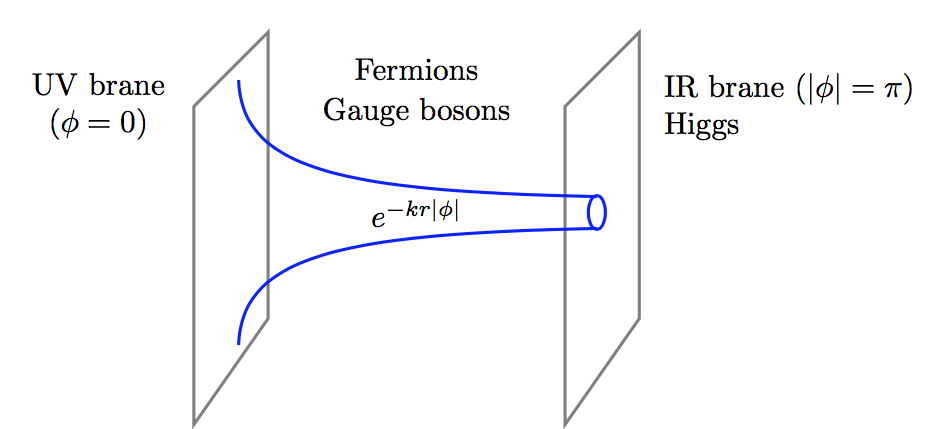

The main motivation for Randall-Sundrum models lies in an "aesthetic" problem of the Standard Model, the Higgs hierarchy puzzle: put simply, it is the question why the squared Higgs mass is 34 orders of magnitude smaller than the squared Planck mass. This separation of scales is seen to be "unnatural". The curvature of the 5D space-time in Randall-Sundrum models allows for an exponential redshifting of the Planck scale to the Tev scale, which reduces the "natural" discrepancy between the squared Higgs and Planck masses to 2-3 orders of magnitude.
In my research, I have investigated the fermion triangle diagram in the context of Randall-Sundrum models. By using the method of 5D propagators one can calculate the corresponding amplitude and show that the result differs for models with a brane-localised and a narrow bulk-Higgs sector [2]. After understanding this calculation I have worked out the phenomenological implications for the Higgs production process via gluon fusion. Later on, I have further investigated various other Higgs production and decay channels, which allow to significantly constrain the parameter space of Randall-Sundrum models [3], [4]. After working on Higgs physics, I have switched my attention to the flavour-changing transition b to s gamma. Using 5D propagators, I have calculated the leading penguin diagrams to the transition at the one-loop level [5]. With the numerical results, one can compare the predictions in the Randall-Sundrum models with several observables that are measurable at the B-factories.
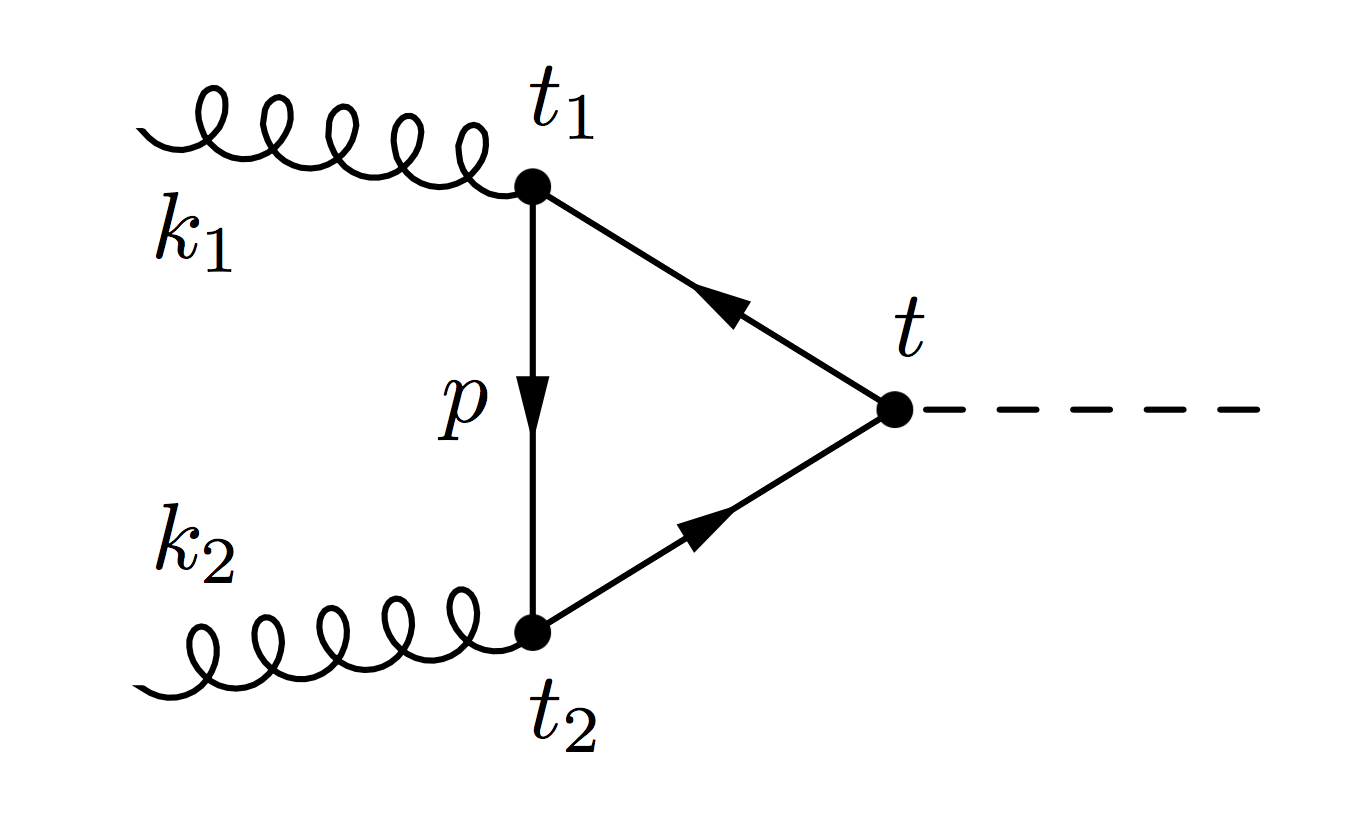

However, up to now the collaborations at collider experiments have not found any significant deviation from the predictions of the Standard Model. In addition, for many models, that aim at an explanation of the Higgs hierarchy puzzle, the new physics scale gets pushed into the multi-TeV range. Consequently, the original motivation - the solution to the Higgs hierarchy puzzle - is under strong tension for many models beyond the Standard Model.
Prior to that, I was developing software in Python and JavaScript using agile methods, CI/CD and cloud technology at d-fine GmbH.
I'm a former researcher at the Dalle Molle institute for artificial intelligence (IDSIA) in Lugano, Switzerland in the group of Prof. Dr. Juergen Schmidhuber. I have been working on a project dealing with curiosity in Reinforcement Learning [technical_report][code]. During this time I have also given three lectures on Evolutionary Algorithms [pdf].
My scientific background is originally in physics. I have obtained my diploma and PhD in theoretical high energy physics at the Johannes Gutenberg-University in Mainz, Germany, under the supervision of Prof. Dr. Matthias Neubert. In my research I have investigated Higgs and flavour physics in models with one warped extra dimension, the so-called Randall-Sundrum models. My work involved model building for elementary particles and the analytical calculation of Feynman loop-diagrams in a 5-dimensional warped space-time and the subsequent numerical analysis using Mathematica. The predictions can then be tested in particle collision experiments like the Large Hadron Collider at CERN near Geneva.

Impact of warped extra dimensions on the dipole coefficients in b to s gamma transitions
R. Malm, M. Neubert, C. Schmell
[JHEP 04, 042 (2016)] [arXiv: 1509.02539 [hep-ph]] [talk][poster]
We calculate the electro- and chromomagnetic dipole coefficients in the context of the minimal Randall-Sundrum model with a Higgs sector localized on the IR brane using the five-dimensional approach, where the coefficients are expressed in terms of integrals over 5D propagators.
R. Malm, M. Neubert, C. Schmell
[JHEP 04, 042 (2016)] [arXiv: 1509.02539 [hep-ph]] [talk][poster]
We calculate the electro- and chromomagnetic dipole coefficients in the context of the minimal Randall-Sundrum model with a Higgs sector localized on the IR brane using the five-dimensional approach, where the coefficients are expressed in terms of integrals over 5D propagators.

Higgs Couplings and Phenomenology in a Warped Extra Dimension
R. Malm, M. Neubert, C. Schmell,
[JHEP 02, 008 (2015)] [arXiv: 1408.4456 [hep-ph]] [talk]
We present a comprehensive description of the Higgs-boson couplings to Standard Model fermions and bosons in Randall-Sundrum (RS) models with a Higgs sector localized on or near the infra-red brane.
R. Malm, M. Neubert, C. Schmell,
[JHEP 02, 008 (2015)] [arXiv: 1408.4456 [hep-ph]] [talk]
We present a comprehensive description of the Higgs-boson couplings to Standard Model fermions and bosons in Randall-Sundrum (RS) models with a Higgs sector localized on or near the infra-red brane.

Higgs Decay into Two Photons at the Boundary of a Warped Extra Dimension
J. Hahn, C. Hörner, R. Malm, M. Neubert, K. Novotny, C. Schmell
[ Eur. Phys. J. C74, 2857 (2014)] [arXiv: 1312.5731 [hep-ph]] [talk]
A detailed five-dimensional calculation of the Higgs-boson decay into two photons is performed in both the minimal and the custodially protected Randall–Sundrum (RS) model, where the Standard Model (SM) fields propagate in the bulk and the scalar sector lives on or near the IR brane.
J. Hahn, C. Hörner, R. Malm, M. Neubert, K. Novotny, C. Schmell
[ Eur. Phys. J. C74, 2857 (2014)] [arXiv: 1312.5731 [hep-ph]] [talk]
A detailed five-dimensional calculation of the Higgs-boson decay into two photons is performed in both the minimal and the custodially protected Randall–Sundrum (RS) model, where the Standard Model (SM) fields propagate in the bulk and the scalar sector lives on or near the IR brane.

5D Perspective on Higgs Production at the Boundary of a Warped Extra Dimension
R. Malm, M. Neubert, K. Novotny, C. Schmell
[JHEP 01, 173 (2014)] [arXiv: 1303.5702 [hep-ph]] [talk] [poster]
A comprehensive, five-dimensional calculation of Higgs-boson production in gluon fusion is performed for both the minimal and the custodially protected Randall-Sundrum (RS) model, with Standard Model fields propagating in the bulk and the scalar sector confined on or near the IR brane. For the first time, an exact expression for the gg->h amplitude in terms of the five-dimensional fermion propagator is derived, which includes the full dependence on the Higgs-boson mass.
R. Malm, M. Neubert, K. Novotny, C. Schmell
[JHEP 01, 173 (2014)] [arXiv: 1303.5702 [hep-ph]] [talk] [poster]
A comprehensive, five-dimensional calculation of Higgs-boson production in gluon fusion is performed for both the minimal and the custodially protected Randall-Sundrum (RS) model, with Standard Model fields propagating in the bulk and the scalar sector confined on or near the IR brane. For the first time, an exact expression for the gg->h amplitude in terms of the five-dimensional fermion propagator is derived, which includes the full dependence on the Higgs-boson mass.

A Solution to the Flavor Problem of Warped Extra-Dimension Models
M. Bauer, R. Malm, and M. Neubert
[Phys. Rev. Lett. 108, 081603 (2012)] [arXiv: 1110.0471 [hep-ph]] [talk] [poster]
A minimal solution to the flavor problem of warped extra-dimension models, i.e. the excessive mixed-chirality contribution to CP violation in K-Kbar mixing arising from Kaluza-Klein (KK) gluon exchange, is proposed. Extending the strong-interaction gauge group in the bulk by an additional SU(3), and breaking this symmetry to QCD via boundary conditions, the constraints arising from the epsilon_K parameter are significantly relaxed.
M. Bauer, R. Malm, and M. Neubert
[Phys. Rev. Lett. 108, 081603 (2012)] [arXiv: 1110.0471 [hep-ph]] [talk] [poster]
A minimal solution to the flavor problem of warped extra-dimension models, i.e. the excessive mixed-chirality contribution to CP violation in K-Kbar mixing arising from Kaluza-Klein (KK) gluon exchange, is proposed. Extending the strong-interaction gauge group in the bulk by an additional SU(3), and breaking this symmetry to QCD via boundary conditions, the constraints arising from the epsilon_K parameter are significantly relaxed.
-
Five-dimensional Perspective on Higgs Physics and the b to s gamma Transition in a Warped Extra Dimension [pdf]
R. Malm, Johannes-Gutenberg University Mainz, Germany
This thesis studies the Higgs-boson production and decay processes as well as the flavor-changing neutral current b to s gamma in models with one warped extra dimension, where the gauge bosons and fermions propagate into the bulk and the Higgs sector is localized on or near the infra-red brane.
-
Mitigation of the Epsilon K Fine-tuning Problem in the Randall-Sundrum Model [pdf]
R. Malm, Johannes-Gutenberg University Mainz, Germany
In order to mitigate the tension between the theoretical and the experimental value of Epsilon K within the RS framework, we will present an extension of the Minimal RS model, that will include the proposal of a new colored gauge boson as well as a first treatment of the new Higgs sector.
exercise sheets: [1] [2] [3] [4] [5] [6] [7] [8]
exercise sheets: [1] [2] [3] [4] [5] [6]
exercise sheets: [1a] [1b] [2] [3] [4] [5] [6] [7] [8] [9]


The main motivation for Randall-Sundrum models lies in an "aesthetic" problem of the Standard Model, the Higgs hierarchy puzzle: put simply, it is the question why the squared Higgs mass is 34 orders of magnitude smaller than the squared Planck mass. This separation of scales is seen to be "unnatural". The curvature of the 5D space-time in Randall-Sundrum models allows for an exponential redshifting of the Planck scale to the Tev scale, which reduces the "natural" discrepancy between the squared Higgs and Planck masses to 2-3 orders of magnitude.
In my research, I have investigated the fermion triangle diagram in the context of Randall-Sundrum models. By using the method of 5D propagators one can calculate the corresponding amplitude and show that the result differs for models with a brane-localised and a narrow bulk-Higgs sector [2]. After understanding this calculation I have worked out the phenomenological implications for the Higgs production process via gluon fusion. Later on, I have further investigated various other Higgs production and decay channels, which allow to significantly constrain the parameter space of Randall-Sundrum models [3], [4]. After working on Higgs physics, I have switched my attention to the flavour-changing transition b to s gamma. Using 5D propagators, I have calculated the leading penguin diagrams to the transition at the one-loop level [5]. With the numerical results, one can compare the predictions in the Randall-Sundrum models with several observables that are measurable at the B-factories.


However, up to now the collaborations at collider experiments have not found any significant deviation from the predictions of the Standard Model. In addition, for many models, that aim at an explanation of the Higgs hierarchy puzzle, the new physics scale gets pushed into the multi-TeV range. Consequently, the original motivation - the solution to the Higgs hierarchy puzzle - is under strong tension for many models beyond the Standard Model.
